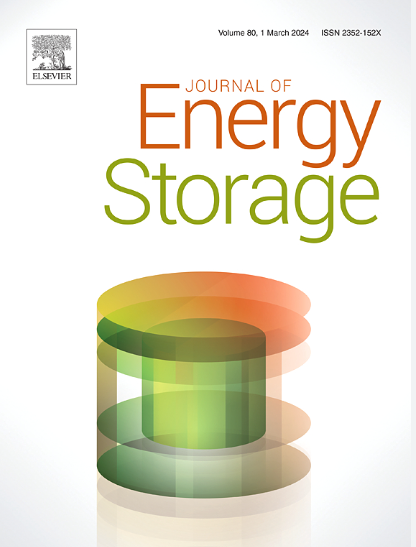Airtightness evaluation of compressed air energy storage (CAES) salt caverns in bedded rock salt
IF 8.9
2区 工程技术
Q1 ENERGY & FUELS
引用次数: 0
Abstract
CAES technology provides large-scale clean energy storage of electric energy and enhances the spatio-temporal structure of power generation and utilization. The airtightness of salt caverns is essential for the economic viability of CAES systems. In this paper, a thermo-hydro-mechanical (THM) model is proposed for assessing the airtightness of CAES salt caverns in bedded rock salt. The accuracy of the model was verified using field data. Furthermore, the permeability and porosity of the rock salt and interlayer in the target cavern section were measured based on the Yunying salt district as the engineering background, and a 3D geomechanical model was established. The variations in temperature and pressure in the cavern were analyzed. Meanwhile, the seepage range, pore pressure, safety factor, and leakage amount of the JD5 and JD6 well groups under different cases within 1 year of operation were explored. The results indicate that the permeability magnitudes of rock salt and interlayer are on the order of magnitudes of 10−18 m2 and 10−19 m2. The interlayer serves as the primary channel for air leakage. When the permeability of the interlayer is lower than 1 × 10−18 m2, the percentage of air leakage from the CAES salt cavern is less than 1 %, and the JD5 and JD6 well groups exhibit excellent airtightness. When evaluating the airtightness of CAES salt caverns, the mass percentage of air leakage, pore pressure, and stability are recommended to be considered together. This study provides references for future airtightness evaluations of CAES projects in salt caverns.
层状岩盐中压缩空气储能(CAES)盐穴的气密性评估
CAES 技术可提供大规模的清洁电能储存,并改善发电和用电的时空结构。盐洞的气密性对 CAES 系统的经济可行性至关重要。本文提出了一种热-水-机械 (THM) 模型,用于评估层状岩盐中 CAES 盐洞的气密性。该模型的准确性通过现场数据得到了验证。此外,以云英盐区为工程背景,测量了目标岩洞段岩盐和夹层的渗透率和孔隙率,并建立了三维地质力学模型。分析了岩洞内温度和压力的变化。同时,探讨了 JD5 和 JD6 井组在不同情况下运行一年内的渗流范围、孔隙压力、安全系数和渗漏量。结果表明,岩盐和夹层的渗透率分别为 10-18 m2 和 10-19 m2。夹层是空气泄漏的主要通道。当夹层的渗透率低于 1 × 10-18 m2 时,CAES 盐穴的漏气率小于 1%,JD5 和 JD6 井组表现出良好的气密性。在评估 CAES 盐穴气密性时,建议将漏气质量百分比、孔隙压力和稳定性综合考虑。本研究为今后盐穴 CAES 项目的气密性评估提供了参考。
本文章由计算机程序翻译,如有差异,请以英文原文为准。
求助全文
约1分钟内获得全文
求助全文
来源期刊

Journal of energy storage
Energy-Renewable Energy, Sustainability and the Environment
CiteScore
11.80
自引率
24.50%
发文量
2262
审稿时长
69 days
期刊介绍:
Journal of energy storage focusses on all aspects of energy storage, in particular systems integration, electric grid integration, modelling and analysis, novel energy storage technologies, sizing and management strategies, business models for operation of storage systems and energy storage developments worldwide.
 求助内容:
求助内容: 应助结果提醒方式:
应助结果提醒方式:


